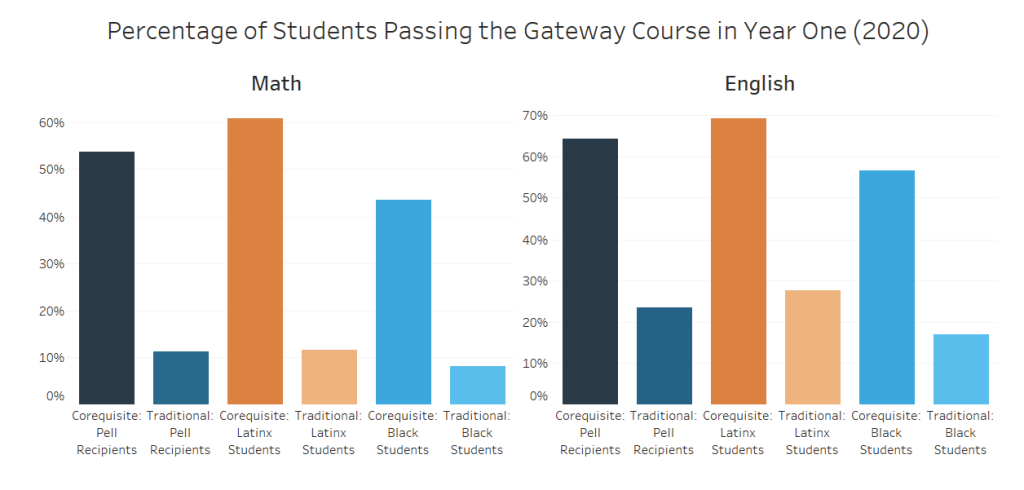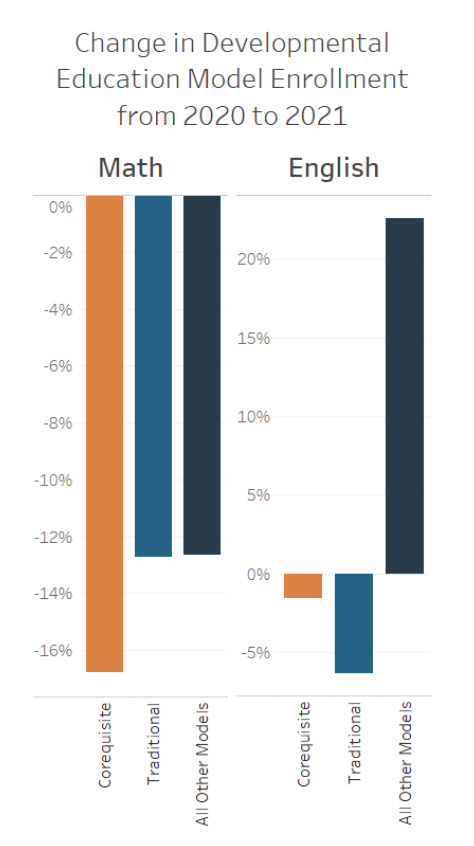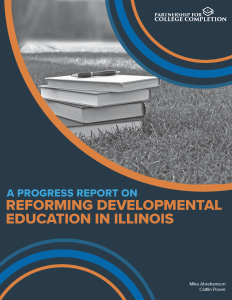Mike Abrahamson, Caitlin Power
Acknowledgements
This report was completed with support from Ascendium Education Group. The report was authored by the Partnership for College Completion’s Mike Abrahamson, Senior Manager of Research & Policy, and Caitlin Power, Policy Analyst. It was made possible with editing from Abby Higgins. We would also like to thank our PCC colleagues and partners who generously reviewed this report.
Introduction
Developmental Education, an institutional practice originally designed to fill gaps for students deemed unprepared for college courses, has become one of the most glaring sources of inequity in Illinois higher education. Every year, tens of thousands of students were required to take remedial classes for no credit before they could attend credit-bearing courses.
These students were disproportionately community college students of color and those from low-income backgrounds, and most of them never made it beyond this barrier. Over a decade of research now shows that the extra time and money caused students to leave college unnecessarily.
The Developmental Education Reform Act (DERA), as part of Illinois HB 2170, was signed into law in March 2021 to address these inequities. There are two crucial elements:
- Placement reforms: Institutions must place students in college-level courses if they meet standards on any one of multiple measures, including GPA and transfer credit.
- Model scaling: Institutions must submit plans to implement and scale the developmental education model that evidence shows is most likely to “maximize students’ likelihood of completing gateway courses in mathematics and English within their first two semesters.”1
This is the first of periodic reports from PCC that will bring the latest and most relevant data to bear on DERA implementation, showing successes, areas for improvement, and future metrics to evaluate change. It both celebrates efforts thus far and holds colleges accountable for giving students the best and most equitable opportunities to succeed in credit-bearing courses, in keeping with the spirit of DERA.
Executive Summary
This report is being published just over two years after the SB 815 bill was signed in August of 2021, meaning implementation is in its early stages. However, there are already some high-level successes.
- 28.8% of community college students from Illinois’ graduating Class of 2021 had to take developmental education courses, compared to 49.4% from the Class of 2014
- Math developmental education enrollment declined 12.4% from 2020 to 2021
- Corequisite is the most effective model for students passing gateway courses in year one2
- 56% of corequisite math students pass a gateway course in the first year – no other model saw more than an 18% passing rate
- 66% of corequisite English students pass a gateway course in the first year, compared to 26% for the traditional model
- Black and Latinx corequisite students were 5 times more likely to pass a math gateway course compared to traditional models, and 2-3 times more likely in English
- Pell-eligible corequisite students were 5 times more likely to pass a gateway course in math and almost 3 times more likely in English compared to the traditional models
- 96.5% of Illinois public institutions offer corequisite math and 87% offer corequisite English, though the models are not necessarily fully scaled
Amidst progress, however, data and reporting on placement and corequisite scaling raise concerns about compliance with legislation and whether institutions are giving students the best and most equitable opportunities.
- Less than 17% of the state’s colleges are compliant with DERA’s placement requirements
- An incorrect interpretation of the DERA legislation’s placement requirements as partly optional has surfaced, which may be lowering compliance
- Instead of scaling up, the latest data show corequisite declining in comparison to other models
To both support institutions and hold them accountable, PCC has identified key metrics colleges and the state must monitor to track positive progress.
- The state needs to track full compliance to the DERA placement reforms and ensure it increases toward 100% in coming years
- Colleges and the state must track both the number and percentage of students enrolled in developmental education and ensure it keeps declining
- Meanwhile, colleges and the state must also monitor the percentage of developmental education students enrolled in corequisite models to ensure it continues to increase
- The state must continue to track the percentage of gateway course completions in year one, which will be a key marker of success
Metrics that show Illinois is on the right track
Illinois’ developmental education enrollment, placement, and outcomes reveal critical successes the state can build on.
Fewer Illinois students are enrolling in developmental education

According to ISBE data, the percentage of students taking developmental courses has been almost cut in half over the last 6 years. In 2014, 49.4% of community college students from Illinois’ graduating high school class took remedial courses, and by 2021 that number was just 28.8%. Some of this is likely due to demographic changes, since 8,600 fewer Illinois high school graduates attended community college in 2021 than 2014. However, 11,200 fewer students are now placed in developmental education in Illinois, meaning lower enrollment numbers don’t wholly account for the large decline. Moreover, Illinois saw a particularly sharp decrease as the legislation was taking effect in 2021, but has since plateaued.
Data from ICCB also shows a decline in developmental education enrollment relative to overall enrollment from 2020 to 2021 – English developmental education declined 3.6% and math declined 12.4% compared to a 1.6% overall decline in the number of undergraduates at community colleges.
Corequisite models have proven far more successful than any other model
The DERA legislation specifies that institutions must scale the model that maximizes the likelihood of students completing gateway courses in math and English in their first year. Recently reported data from Illinois has definitively shown corequisite is the only model that can be scaled in compliance with DERA. In math, corequisite remediation is almost four times more effective than any other model (including Compressed, Emporium, Modularized, and others) and in English it’s more than twice as effective.3
Individual institutions reported even greater differences: one college, for example, reported that 3.2% of traditional math students passed the gateway course compared to 58.8% of corequisite students.4

Corequisite models are far more effective for students of color and students from low-income backgrounds
Corequisite success is even more stark when it comes to students of color and students from low-income backgrounds. Black and Latinx corequisite students were four times more likely to pass a math gateway course compared to traditional models and 2-3 times more likely in English. Similarly, Pell-eligible corequisite students were 5 times more likely to pass a gateway course in math and almost 3 times more likely in English compared to traditional model.

Policies, plans, and metrics that show we need to catalyze change
Corequisite models are mostly in place, they just need to be scaled
96.5% of public colleges and universities offer corequisite math and 88% offer corequisite English. Institutions are currently trying 16 alternate models in math and 13 in English, but no other model has been adopted by even half of campuses, and none come close to a plurality. However, the next section will show that despite having some infrastructure for corequisite courses, they have not been meaningfully scaled.
There is still a long way to go for Illinois colleges to comply with DERA and for students to have the opportunities they need to pass college-level courses. Colleges especially need to improve implementing and reporting on placement measures and the lack of scaling of corequisite remediation.
Interpretation of placement legislation
The DERA legislation’s placement policies seemed clear at the time it was passed: colleges must have multiple measures by which students can qualify for college level courses — and each measure must be considered individually. This means that a student with a high GPA has demonstrated readiness for college courses regardless of their score on a placement test.
DERA Placement Legislation
A. On or before May 1, 2022, a community college shall use each of the following measures, as appropriate, to determine the placement of a student in introductory college-level English language or mathematics coursework and shall use the scores set forth in recommendations approved by the Illinois Council of Community College Presidents on June 1, 2018:
- A student’s cumulative high school grade point average.
- A student’s successful completion of an appropriate high school transition course in mathematics or English.
- A student’s successful completion of an appropriate developmental education or introductory college-level English language or mathematics course at another regionally accredited postsecondary educational institution.
B. If a student qualifies for placement in an introductory college-level English language or mathematics course using a single measure under subsection (a) or (b), no additional measures need to be considered for placement of the student in the introductory college-level English language or mathematics course.
Since this legislation passed, some institutions appear to be using the “as appropriate” language as a caveat to invalidate some measures listed in section (a) as standalone criteria to be placed in college-level courses. In such cases, institutions are essentially arguing that some measures (even ones as readily available and evidence-supported as high school GPA) are not appropriate for their placement.
This claim is an incorrect interpretation of the legislation. The “as appropriate” merely allows a college to opt out of administering unnecessary tests – a college wouldn’t have to start administering a specific evaluation exam (i.e. the Accuplacer test) just because it’s one possible measure, for example. However, even if a college believed the “as appropriate” language meant that it could ignore required placement methods, section (c) still requires them to let students into credit-bearing courses if they individually satisfy “a single measure.”5
Adherence to “multiple measures” placement legislation
Unclear and/or conflicting reporting make it hard to know exactly how many colleges are complying with DERA’s placement requirements. However, an analysis of institutional plans from Johns Hopkins University’s Center for Research and Reform in Education (CRRE) and PCC showed only 8 of Illinois’ 48 community colleges accepted all three of the measures listed in section (a) of the DERA legislation.6 This means that, as of 2022, at most 16.6% of the state’s colleges are compliant with the law’s placement component.
Scaling of corequisite, the model that maximizes students’ opportunities
Despite mounting evidence that corequisite is the model that gives students the best chance of passing gateway courses, this model saw relatively less utilization across community colleges’ math courses in 2021 than 2020. All models declined in enrollment, likely due to overall enrollment declines and placement reform success. However, corequisite declined by a greater percentage than the traditional model or the combination of other models. In English, the traditional model declined by a greater percentage than corequisite. The combination of all other models, however, significantly increased enrollment from 2020 to 2021. This was led by an 80% increase in the Compressed math model, which also saw a 42% increase in English developmental education students despite no evidence of success for either math or English students relative to corequisite models.7 The numbers of Compressed students are small, particularly in English, but the trend is still concerning. While scaling other models is not expressly disallowed by the law, it’s not in the spirit of it. Why colleges would avoid placing students in corequisite courses in favor of unproven methods, let alone models it clearly outperforms, is unclear.
The change we are hoping to see

Community colleges serve many different missions and student populations and they need clarity on what’s expected of them. Therefore, to both support institutions and hold them accountable, we need to proactively identify the evidence of positive change we are expecting to see.
Uniformity in placement across colleges
Right now, where a student lives unfortunately determines the opportunities they’ll have to take college-level courses. There are a dozen different measures that various colleges require to take a credit- bearing class.8 In one college district, a student may have to take ALEKS, and in another they may have to take Accuplacer. These variations exist in spite of the fact that the law makes it clear that all tests are unnecessary unless a student fails to place in with their GPA. While it’s important to track all of the different measures for placement across colleges, the state must insist on a simpler metric: full compliance to the DERA placement law. First, exactly how many institutions are conforming to the legislation must be publicly available (right now we only know it’s less than 17%) and then colleges must work to increase that percentage toward 100%.
Placement declines into developmental education
Enrollment in developmental education has been precipitously declining over the past five years — a positive sign especially since that number appears to have dropped even more steeply after the introduction of DERA. However, it’s important to continue tracking the percentages of students enrolled in developmental education. Looking at overall percentages can mask more granular unrelated or negative trends, so it’s also essential to disaggregate the students placed in developmental education by race, income, and placement measure and scores.
Scaling of the corequisite model
The DERA Act does not mandate a particular model but instead requires that institutions scale the one where students are mostly likely to succeed in gateway courses within their first year. Any good faith reading of data on Illinois community colleges plainly shows that corequisite remediation has unparalleled success. Despite this evidence, there are 13 other English models and 16 other math models still used sporadically across college campuses. More importantly, only 10% of math developmental education students and 37% of English students are placed in the corequisite model.
As a state, we must monitor the percentage of developmental education students who are enrolled in corequisite models to ensure colleges are complying with legislation and that students have the best chance to succeed.
Overall outcomes of students placed into developmental education
As better placement measures and corequisite remediation are scaled up we will see the percentage of first-year gateway course completions rise. That should be true of students entering developmental education, as well as overall. These numbers and percentages will translate to real world success as thousands more students earn college credits and move closer to a degree. These students will be the ultimate marker of developmental education reform success.
Revisit and follow through on institutional plans
It would be unrealistic to expect colleges to make systemic reforms without careful planning and it takes time to implement these kinds of large-scale and complex reforms. However, nearly all institutions have already made impressive progress on a short timeframe. Despite 2021 enrollment numbers, there is great momentum in colleges working on corequisite models – 65% of colleges reported to Johns Hopkins CRRE research team that they’re scaling corequisite models in math, and about 44% reported scaling corequisite English. However, even within these plans there is room for improvement: only 18% of institutions reported strategies meant specifically to improve Black student outcomes, for example.
PCC can speak firsthand to the work that’s already underway. Colleges within PCC’s Illinois Equity in Attainment (ILEA) network are building and strengthening their infrastructure to improve educational outcomes. That includes working with PCC and other partners on faculty support, public policy clarification, and hosting convenings that highlight the strides colleges and universities have made in their developmental education reform. PCC plans to work with partners to assess their current progress and ability to scale by evaluating financial and personnel resource allocation, policy reforms, and curriculum changes, using partner feedback. In addition, we plan to support institutions as they grapple with high leadership turnover by assessing leadership transitions, and by helping to establish continuity throughout systemic changes. Targeted support will increase administrator capacity for leading change at their institutions. This can be observed and reported through qualitative data from campuses on the successes and challenges of their developmental education reform work. Ultimately, we hope to see this momentum appear in upcoming data on placement, corequisite enrollment, and outcomes.
End notes
1 Gateway courses are just that—the first courses that all students must take and pass in order to move on to any other courses they would like to take. Without completing the gateway, students may not continue and graduate.
2 Corequisite developmental models refer to credit-bearing courses with simultaneous supports, which may or may not be credit-bearing. Corequisite models are differentiated in a number of ways, and there are many approaches to implementing and scaling them.
3 Comparison of models with at least 100 students. Compressed models combine multiple courses into one; Emporium models use software to help students learn by going through modules, with teacher assistance; Modularized models break courses into smaller sections, often letting students go through these at their own pace. Data used from 2020 – 2021 is available, but the drop in numbers of students reporting in English makes it less reliable. Trends and numbers of students reporting in 2021 data are similar, however.
4 Data from Johns Hopkins University’s Center for Research and Reform in Education analysis of Illinois colleges.
5 For example, if a college claims that GPA is not an “appropriate” measure for their math placement, but it only considers transfer students if they pass an Accuplacer exam, they would still be violating the requirement that states: “using a single measure under subsection (a) or (b), no additional measures need to be considered for placement of the student in the introductory college-level English language or mathematics course.”
6 This includes GPA, transfer credit, and a high school transition course (like dual credit).
7 In 2020, 18% of Compressed mathematics students passed a Gateway course in the first year compared to 56% for Corequisite students. The numbers were too small to report in 2020, but in 2021 only 38% of Compressed students passed an English gateway course in year one compared to 49% for corequisite.
8 The Johns Hopkins CRRE analysis finds 12 measures in use for English and math placement in Illinois.


